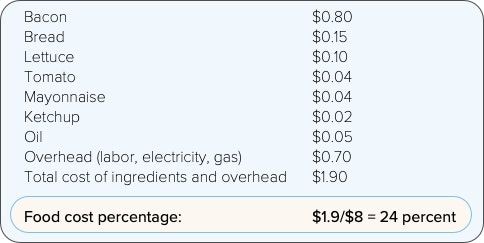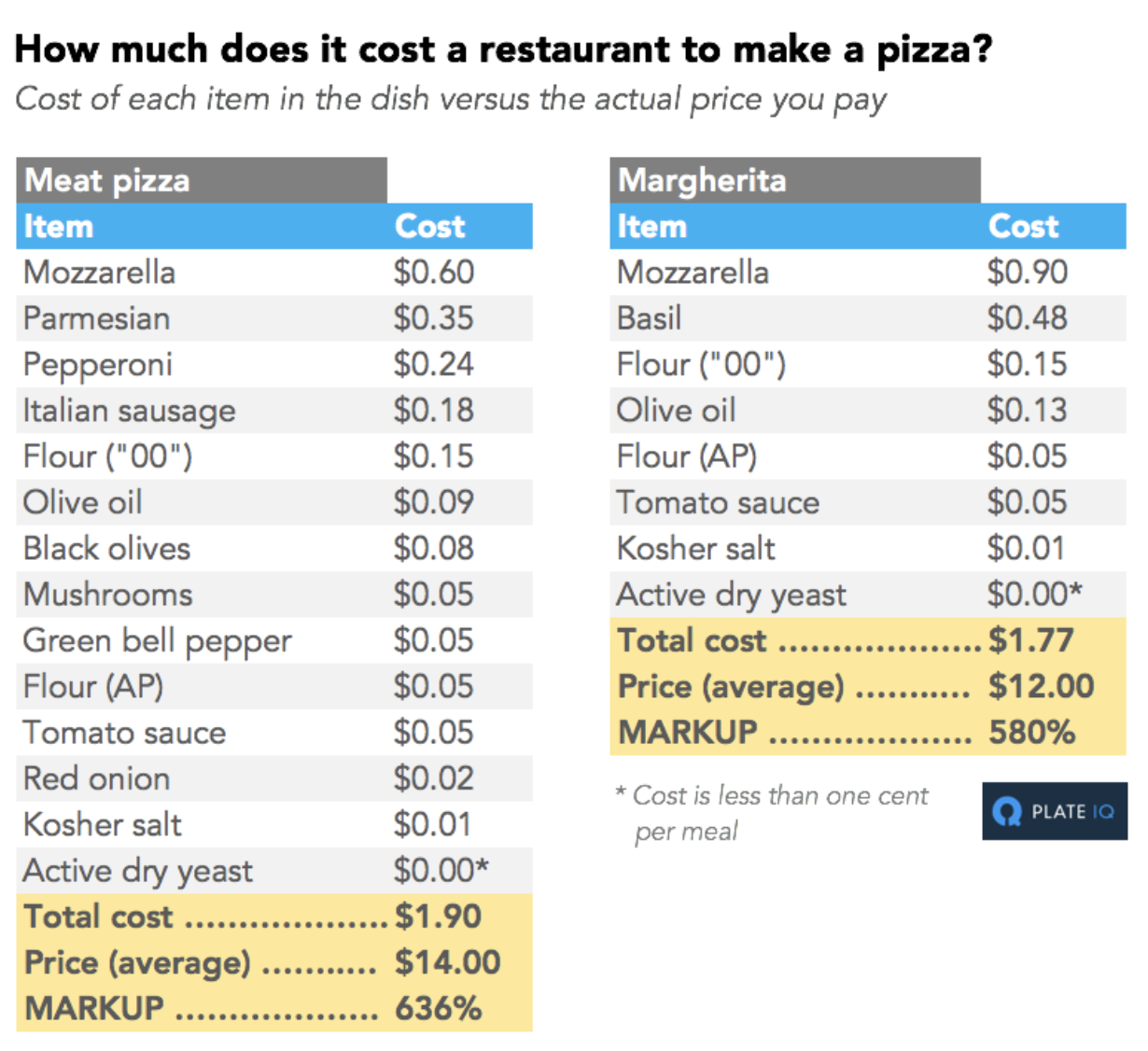4 Strategies for Creating a Profitable Restaurant Menu
Do you know the breakdown cost of each ingredient of every meal on your menu? Or are you just coming up with menu prices based on estimates and what your competitors are charging?
Correctly pricing a menu is fundamental to the success of any restaurant, and rising food prices are an urgent wake-up call for restaurants that aren’t pricing correctly.
According to the United States Department of Agriculture, food prices will increase 1 to 2 percent in 2018. Prices for beef and veal are expected to rise 2 to 3 percent while egg prices are forecast to grow 4 to 5 percent; cereal and bakery prices are also expected to increase 3 to 4 percent.
But rising food prices aren’t the only reason why correctly pricing menu items is vital. Even if diners are flocking to you for your tasty ramen, it does your restaurant no good if you’re losing money on every bowl you put on the table.
Sales of your menu items are your restaurant’s lifeblood. Shrewd meal pricing is necessary to a successful restaurant. Failing to properly price meals can gut your profit margins, leaving your restaurant winding up as yet another cautionary tale on an episode of “The Profit.”
In this article, we’ll explain how small restaurants can begin food pricing and provide four pricing strategies that will help make your restaurant more profitable and competitive.
Here’s what we’ll cover:
Step 1: Calculate Food Costs
Step 2: Implement Markup to Cover Overhead Costs
Step 3: Ensure Portion Control
Step 4: Apply Menu Psychology
Step 1: Calculate Food Costs
What is food cost? Food cost is a percentage used to determine how much money is recouped on the sale of each dish compared to how much it costs to produce the dish. It takes into consideration everything from individual ingredients in the dish to overhead costs such as labor and occupancy fees.
Why it’s important: Everything that goes on your plate must be accounted for. Calculating the costs of every ingredient and overhead component ensures a more precise gross profit as well as an understanding of the profitability of your menu items.
The average food cost percentage is 25 percent for a quick-service restaurant and 35 percent for a fine dining restaurant, so a range between the two is a sign of a financially healthy restaurant.
How to calculate the food costs of each meal**:**
Start by listing the cost of every ingredient required to prepare, cook and garnish your menu item—and we mean every item. That includes seasonings, oils and garnishes.
Next, calculate the cost of every ingredient. Add up the cost of each ingredient to get the total cost of the meal. It can be tedious measuring the costs of items like seasonings and oil, so try doing it based on the batches or the number of sales units you get out of each batch, instead of single servings.
Calculate your fixed cost per meal. Combine all the fixed costs that go into producing the dish such as salaries and occupancy fees. For example, if your daily fixed costs are $1,200 and you serve an average of 120 customers every day, your fixed cost per meal is $10.
Example of a Food Cost Calculation for an $8 BLT

Expert Advice:
“You’ve got to know your costs before setting a price,” says restaurant consultant Linda Lipsky. She recommends that food costs run about 33 percent of menu prices, although that can vary depending on the restaurant and the item.
“A soup could cost as little as 18 cents per serving to make, but you’re not going to sell it for 54 cents,” says Lipsky. Soups, appetizers, desserts and alcohol tend to have lower cost percentages than entrees so consider your sales mix when pricing items.
Step 2: Implement Markup to Cover Overhead Costs
What is food markup? Food markup is the amount of money added to the unit cost of each meal to cover overhead costs. Put simply, food markup is when a restaurant buys items at a certain price and sells them at a higher price to make a profit.
Why it’s important: Remember, you’re not just paying for the cost of food. You’re also paying for an employee’s time and effort to prepare, cook and serve the meals as well as salaries and occupancy.
Marking up the price of ingredients is essential if you’re going to break even and grow your restaurant. According to Plate IQ, which processes invoices for restaurants in the U.S., the common markup for restaurant food items ranges from 155 percent to as high as 636 percent.
How to calculate food markup: To determine what your food markup is for each meal, you’ll first have to calculate your gross profit margin. To do so, take your menu price and subtract the unit cost of the meal from that. For example:
How to calculate your gross profit margin:
If the unit cost of your BLT is $1.90 and the menu price is $8.00, you would calculate your gross profit margin like so:
$8.00 – $1.90 = $6.10 (gross profit margin)
Next, divide your gross profit margin by your unit cost to calculate your markup percentage:
How to calculate your food markup percentage:
If the gross profit margin of your BLT is $6.10, divide that amount by the unit cost of $1.90:
$6.10 / $1.90= 321 percent (food markup percentage)

Example of a detailed markup analysis for a menu item, via PlateIQ (source)
Expert Advice:
If your menu items are too pricey, consider whether you might be able to make the dish for less, says Lipsky. She suggests looking into a more affordable vendor, substituting with another ingredient or making the portion size smaller.
Something to consider: PlateIQ’s study found that out of restaurant revenue, on average, 30 percent goes toward labor costs, 30 percent toward general overhead and 30 to 33 percent toward ingredients.
“What it takes to make a successful restaurant is a very tough formula—to get it all to work together and make a profit,” says Matt Hawkins, a growth advisor at PlateIQ. “When restaurants are pricing out dishes, the majority of the cost there is really made around that experience.”
Step 3: Ensure Portion Control
What is portion control? Portion control refers to the amount of ingredients and food on a plate. For example, if you own a pizzeria, you want to ensure a consistent ratio of meat and vegetables on each pizza to maintain customer satisfaction and consistency.
Why it’s important: Portion control ensures that meals at your restaurant are consistent and meet customer expectations. But more than that, having a firm handle on portion control is also critical to keeping costs in your restaurant in check.
Every item on your menu should have a determined portion size to reduce food costs, keep food costs under control and maintain profitability.
For example, you might charge $4 for an 8-ounce bowl of broccoli soup. However your kitchen staff is using different ladles and overfilling bowls by an ounce or two multiple times a day. For every ounce that the bowl is overfilled, you’re losing 50 cents an order.
It may not sound like a lot, but it adds up over time. When every penny counts toward your bottom line, these discrepancies will impact your profitability more dramatically than you might expect.
How to implement portion control:
Everything needs to be measured and weighed. To do so, you need to get the appropriate portion control tools such as portion scales, food dishes, measuring cups and spoons, serving spoons, ladles etc.
Educate your kitchen staff on the importance of using the correct serving ladles and spoons as well as weighing meats and ingredients into correct portion sizes.
Pre-measure portions and pre-pack them for popular items, to save time and effort.
Expert Advice:
Portion control needs to be implemented incrementally. “If you discover that portioning is a problem across the board with your whole menu, start to make changes systematically,” says Fred Langley, a former chef and restaurant owner. “Do not change everything across the board all at once.”
He advises restaurants implement portion testing with staff. Make a particular dish in three different sizes. “If the larger portion is the way to go for the dish, just price accordingly,” he says.
Step 4: Analyze Menu Psychology
While calculations on food costs, markup and portion control are important considerations, menu psychology matters just as much as the numbers. Diners have the ultimate say in what they’re willing to pay for.
What is menu psychology?: Menu psychology is the application of pricing and placement strategies designed to encourage spending and maximize restaurant profits.
A well-designed menu can increase the likelihood that certain items will be ordered. For example, restaurants can increase sales of high profit or low-cost items depending on the design or placement of these items on the menu.
How to implement menu psychology: Diners tend to scan menus quickly, taking an average of 109 seconds to make a decision, according to Gallup. That means menus have a limited time to influence decision-making in order to maximize profits.
Here are a few factors to consider:
Even before stepping into your restaurant, diners already have an idea of what they’re willing to pay. Do you have an idea of what that amount is?
Scope out what your competitors are charging for dishes similar to yours. What is the price range of their appetizers, entrees and desserts? You don’t want to be overcharging or undercharging by much.
According to Barry Schwartz, author of “Paradox of Choice,” having more options can actually reduce the quality of the customer experience. Ensure your menu is scannable, avoid clutter and try not to overwhelm your diners with too many choices.
Use relative pricing to make some of your most profitable items more appealing than others in order to drive sales for that particular item. For example, if you’re trying to push a particular $15 dish, try positioning it under another dish that is priced at $25. Doing so may create the perception that the $15 dish is of much better value and may drive orders from some customers.
More Food Pricing Tips—and a Reminder
We’ve spent this article sharing key strategies for how you can price your menu profitably and recommendations for how you can implement them.
Here are some additional tips that might help guide you further along:
Prepare for seasons and natural disasters. Be flexible to swapping out menu items depending on what’s available in season or how natural disasters may affect what’s available.
Create a well-balanced menu. Balance your menu with a combination of costly food items that are more likely to fluctuate with ingredients that have more stable prices. An example would be featuring beef and seafood while balancing it out with pasta, chicken and desserts.
Remember that determining food cost isn’t the most important part of pricing your menu. You can calculate all your food costs to a tee but if your customers don’t think the price is right, they won’t be eating at your restaurant and you certainly won’t be attracting new customers. Researching your customers’ buyer personas, spending habits and what competitors are charging are equally as important to the success of menu pricing strategy.
And finally, give us a call at for a free 15-minute consultation at (844) 687-6771 and one of our specialists will discuss the types of restaurant management and food-costing software that will be a good fit for your restaurant.